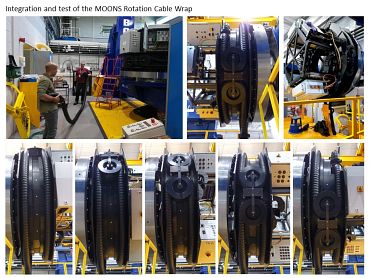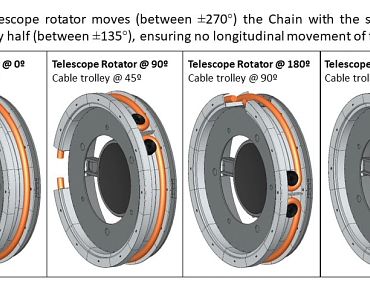A new look at the origin of the universe
Researchers at the University of Lisbon use e-chains for a new type of multi-object spectrograph
Winner of the golden vector award 2024: How did galaxies form? Where do exoplanets with life-friendly conditions exist? A multi-object and near-infrared spectrograph from the Institute of Astrophysics and Space Sciences at the University of Lisbon is expected to provide answers. The engineers rely on energy chains from the igus triflex series for the precise and trouble-free movement of the sensitive optical fibres. For the jury of the vector award 2024, the most spectacular e-chain application.
Profile
- What was needed: Energy chains made of high-performance plastic from the triflex series
- Requirements: The optical fibres of the spectrograph may only be subjected to low loads during movement. In addition, the guidance must work reliably under high ozone levels.
- Industry: Aviation technology
- Success for the customer: The cable guidance works so precisely and gently that it does not interfere with scientific observations. The solution is fail-safe even with permanently high ozone levels.
Problem
The multi-object and near-infrared spectrograph of the Institute of Astrophysics and Space Sciences at the University of Lisbon has a field of view the size of the moon and can simultaneously observe over 1,000 objects in the visible and near-infrared wavelength range. In future, it will be used in the Very Large Telescope (VLT), one of the world's most advanced telescope arrays in the mountains of the Atacama Desert in Chile. The spectrograph is the result of a long development process with various design challenges. One of them was the safe guidance of the sensitive optical fibres that transport the light from a rotating front end to the spectrograph. Even the smallest loads can lead to a falsification of the measurement results. In addition, the cable guidance must work reliably at an altitude of 2,670 metres under high ozone levels in order to prevent expensive system failures.Solution
In order to guide the optical fibres safely from the rotating front end to the spectrograph, the researchers at the Institute of Astrophysics and Space Sciences at the University of Lisbon rely on energy chains made of high-performance plastic from the igus triflex series. The e-chains ensure that the fibres are not exposed to any stress during movement that could jeopardise the scientific observations. According to the engineers, the energy chains fulfil this important task reliably even at an altitude of 2,670 metres and under high ozone levels and extremely low humidity.Institute of Astrophysics at the University of Lisbon


